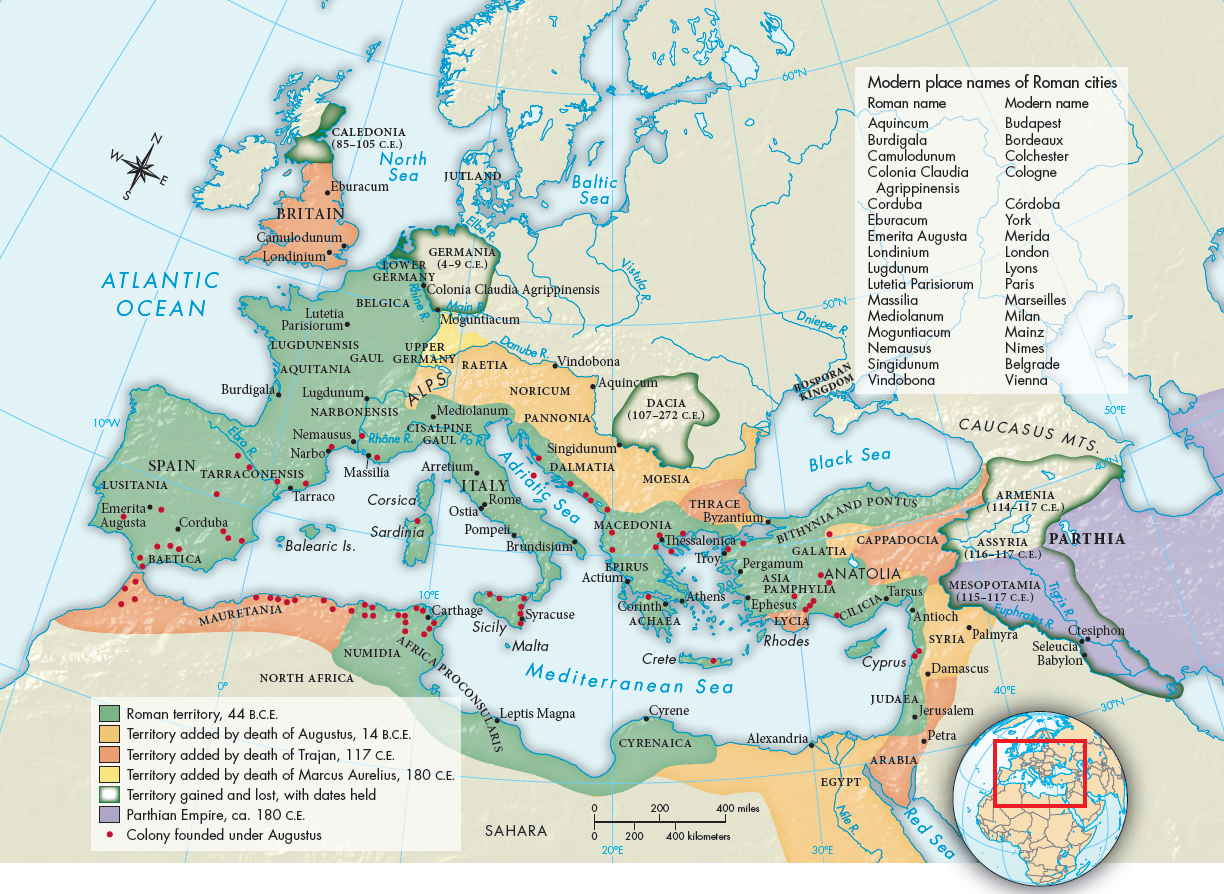Roman Expansion
One of the most significant aspects of Augustus’s reign was Roman expansion into northern and western Europe (Map 6.1). Augustus began his work in the west and north by completing the conquest of Spain begun by Scipio Africanus in the third century B.C.E. (see "The Punic Wars" in Chapter 5). In Gaul he founded twelve new towns, and the Roman road system linked new settlements with one another and with Italy. In 12 B.C.E., Augustus ordered a major invasion of Germany beyond the Rhine. Roman legions advanced to the Elbe River, and the area north of the Main River and west of the Elbe was on the point of becoming Roman. But in 9 C.E., some twenty thousand Roman troops were annihilated at the Battle of the Teutoburg Forest.

Meanwhile Roman troops penetrated the area of modern Austria, southern Bavaria, and western Hungary. Thereafter the Rhine and the Danube remained the Roman frontier in central Europe. The regions of modern Serbia, Bulgaria, and Romania in the Balkans fell, and the Romans created a land-
Within the area along the empire’s northern border, the legionaries and auxiliaries built fortified camps. Roads linked the camps with one another, and settlements grew around the camps. Traders began to frequent the frontier and to do business with the people who lived there. Thus, Roman culture gradually spread north. As a result, for the first time central and northern Europe came into direct and continuous contact with Mediterranean culture. Many Roman camps grew into cities, transforming the economy of the area around them. Roman cities were the first urban developments in most parts of central and northern Europe.
To fortify the a political and religious bonds between the provinces and Rome, Augustus encouraged the cult of Roma et Augustus (Rome and Augustus) as the guardians of the state and the source of all benefits to society. The cult spread rapidly, especially in the eastern Mediterranean, where it built on the ideas of divine kingship developed in the Hellenistic monarchies (see "The Political Legacy" Chapter 4).
To make his presence felt more keenly, Augustus had himself portrayed on coins standing alongside the goddess Victory, and on celebratory stone arches built to commemorate military victories. In addition, he had temples, stadiums, marketplaces, and public buildings constructed in Rome and other cities. Later emperors expanded this imperial cult, erecting monuments and buildings to honor themselves, their family members, or their predecessors. Many of these were decorated with texts as well as images.
The English historian Edward Gibbon dubbed the stability and relative peace within the empire that Augustus created the pax Romana, the “Roman peace,” which he saw as lasting about two hundred years, until the end of the reign of Marcus Aurelius in 180 C.E. This peace was enforced by troops who remained on active duty or as reserves in the provinces and on the frontier, ready to respond to any resistance to Roman dominance. In general, however, Augustus respected local customs and ordered his governors to do the same. Roman governors applied Roman law to Romans living in their territories, but they let local people retain their own laws. As long as they provided taxes and did not rebel, they could continue to run their political and social lives as they had before Roman conquest.
While Romans did not force their culture on local people in Roman territories, local elites with aspirations knew that the best way to rise in stature and power was to adopt aspects of Roman culture. Just as ambitious individuals in the Hellenistic world embraced Greek culture and learned to speak Greek, those determined to get ahead now learned Latin, and sometimes Greek as well if they wished to be truly well educated. As was the case with Hellenization, Romanization and cultural fusion were especially evident in cities.